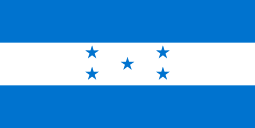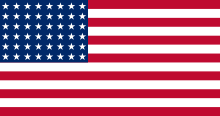List of Lockheed P-38 Lightning operators
| List of Lockheed P-38 Lightning operators | |
|---|---|
 |
The following are units which operated the Lockheed P-38 Lightning:
Operators
 Australia
Australia
The RAAF received five F-4s from August 31, 1942.[1] These aircraft were used for frontline photoreconnaissance sorties. Three served with No. 1 Photo Reconnaissance Unit RAAF and two were attached to a fighter unit, No. 75 Squadron RAAF. The first to enter service with the RAAF, A55-1 was also the last to retire, following a crash on September 1, 1944.
 China
China
Republic of China received 15 P-38Js and P-38Ls and, postwar, they also flew a similar number of F-5Es and F-5Gs.[2]
 Colombia
Colombia
.svg.png) Free France
Free France
- Group 2/23 operated F-5As[3]
- Groupe de Reconnaissance 2/33 operated the F-5G
.svg.png) Nazi Germany
Nazi Germany
- Zirkus Rosarius operated a few captured aircraft.
 Honduras
Honduras
Honduras received 12 aircraft postwar.
_crowned.svg.png) Kingdom of Italy
Kingdom of Italy
Italian pilots started to face P-38s from late 1942 and these fighters, with their long range, high speed and powerful weaponry, were quickly established as a more dangerous foe than the previously used Supermarine Spitfire. A few P-38s fell into the hands of Germans and Italians,[4] and, differently from captured Spitfires, these aircraft were tested and used in combat. P-38s were pitted against nearly all of the fighters in the Italian arsenal in tests at Guidonia and apparently, it fared well. Col. Tondi used a P-38, probably an 'E' version, that landed, because a navigation error, in Sardinia. Tondi then claimed at least 1 B-24 in his captured P-38, downed 11 August 1943. Shortly before Tondi attacked the bomber, an Italian Macchi MC.202 or 205 attacked, doing little damage. However, the heavy armament of P-38 proved devastating, indeed.
- 3° Aerobrigata RT
- 4° Aerobrigata
After capitulation, the Italian Co-Belligerent Air Force flew F-5A photo-reconnaissance missions.[3] The Italian Air Force operated 50 late model aircraft postwar.
 Italy
Italy
- 3° Stormo
- 4° Stormo
After the war, Italy received 120 P-38s[5] in an agreement dated April, 1946. Those heavy fighters, mainly P-38Ls, but also F-5s, were put in service in 4 Stormo. They flew reconnaissance missions over the Balkans, as well as ground attack, naval cooperation and air superiority missions. Delivered after a one-month refurbishing, they finally were all sent to AMI not before 1952. Other wings, like 3 Stormo, used the P-38 as well. Due at the big dimensions of this fighter, the old engines and pilot error, a very high number of P-38s were lost in accidents. At least 30 crashes of P-38s in Italian service claimed a number of victims. Despite this, many Italian pilots liked the fighter, due to its excellent visibility on the ground and its stability at take off. Finally, P-38s were phased-out in 1956. Today, no Italian P-38s survive, nor even a single component from one, as these aircraft, with the value of light alloys, were quickly dismantled.
 Portugal
Portugal
Two interned Lightnings were forced to land in Lisbon, Portugal, while on a ferry flight from England to Algeria. Both were used by PoAF.[2]
 Soviet Union
Soviet Union
Soviet Union operated few damaged and repaired ex-USAAF aircraft found in Eastern Europe.
 United Kingdom
United Kingdom
The United Kingdom performed evaluation tests only.[2]
 United States
United States
See also
| Wikimedia Commons has media related to P-38 Lightning. |
References
- Notes
- ↑ Crick, Darren. "ADF Aircraft Serial Numbers RAAF A55 Lockheed P-38E Lightning." adf-serials.com.au, 2003. Retrieved: 2 April 2009.
- 1 2 3 Baugher, Joe. "P-38s with US Navy and Foreign Air Forces." USAF Fighters, 13 June 1999. Retrieved: 6 February 2007.
- 1 2 Bodie, 1991, p. 240.
- ↑ Harold Skaarup (23 May 2006). RCAF War Prize Flights, German and Japanese Warbird Survivors. iUniverse. p. 222. ISBN 978-0-595-84005-2.
- ↑ "Birth of Aeronautica Militare" Aeronautica Militare
- Bibliography
- Scutts, Jerry. Lockheed P-38 Lightning. London: Crowood, 2006. ISBN 1-86126-770-3.